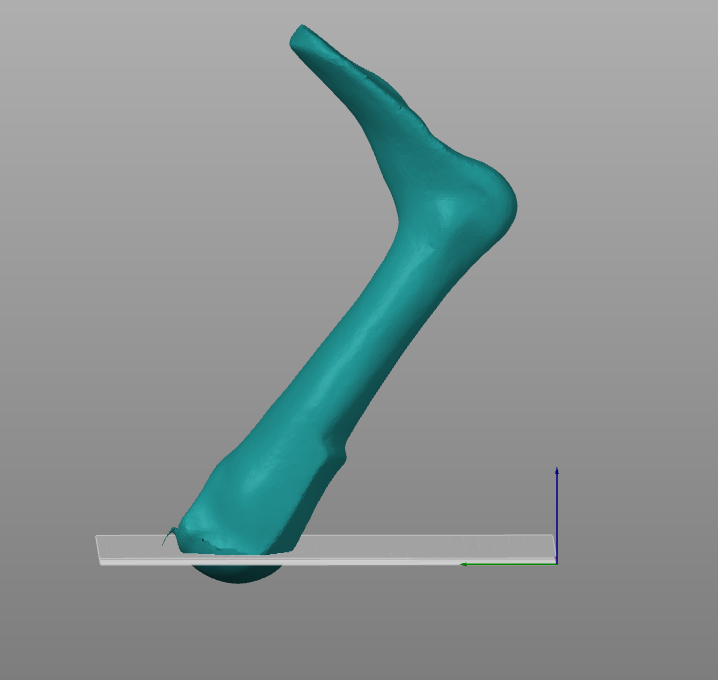estimate cooling performance?
-
Hi,
I work in orthopedics and I have certain models, that I print over and over with very little variation and its basically one big vase with 40-50cm height, which takes 5-7hrs.

I recently switched from ideamaker to prusaslicer and Im finetuning the profile for speed/overall print time. I have a good idea of how much extrusion volume my hotend can handle.
Im printing PLA relatively hot at 220-225 to get good layerbonding and overall form stability. I use a 1mm nozzle, and a bondtech style extruder.So the main limiting factor is cooling, so I set the minimum layer time to 12s and allowed to print to slow down to 10mm/s, otherwise some overhangs really start to suffer.
Since I cant visualize cooling as nicely as extrusion volume I wonder how I can estimate the "heat evaporation", so get an optimized min layertime.
I had two ideas:
- printing thinner layer (.2mm) at faster speed in order for the model cooling fans to move around more and overall have less material that can cool fast.
- printing thicker layers (.3-.4mm) at slower speed whereby the thicker layers are more self isolating, but also concentrate the fan cooling power longer on the same spot because they move slower.
What would be your method to optimze cooling?
Cheers F.
-
@sungod3k it may be helpful if you shared your actual cooling setups. There are variants out there that push a lot of cooling (4028 coolers, Berd Air, CPAP blower setups...). It may be possible to give you pointers to better setups for your machine. And even if you don't use the full cooling power all the time, it may be more quiet running a more capable setup at limited performance.
-
@oliof I use a stock raise 3d pro+ its a traditional hotend setup with two side mounted 20x20 fans fans a short cooling duct. I run it with the two sidepanels/doors open "always on".
I actually tried the berd air, it hella loud and I had to activly cool the pump motor and since im printing for so long I felt uncomfortable risking the the pump burning out

I saw some voron setups for the speed benchy with huge blowers that create a crosswind across the bed but wouldnt that risk overcooling and delamitnation? there needs to be some time for the material too bond.
maybe then a thicker layer is better because it can still radiate some heat from its center even after blower has moved on..
-
This post is deleted! -
@sungod3k It doesn't look like your example print has a lot of detail that needs to be produced. A lot of my prints are similar. I usually use a 1 mm nozzle and print in 0.5 mm layers at typically 30-40 mm/sec print speed. The volume of plastic extruded is 15-20 mm^3/sec which is equivalent to running a typical 0.4mm nozzle with 0.2 mm layers at 187-250 mm/sec, except that you don't get the ringing and other high speed related artifacts.
For cooling I use a single, 30mm radial blower with a U shaped nozzle that wraps around the heater block and it seems to work fine for most things. Lately I'm considering going back to a CPAP blower that I used for a short time and ultimately decided was excessive back when I was using a 0.4 mm nozzle, and a single drive gear extruder as I am not happy with some of the artifacts caused by the dual drive gear teeth in the current BMG extruder.
-
@mrehorstdmd right i dont need detail and the printer also has the tendency for z axis banding, so beauty prints im not producing^^
ive also trimmed the printer for 15m³/s volume. I recently tried cnc kitchens flow calibration but the gcode didnt run correctly for some reason, but just from experimentation i feel that 15 is the volume limit. but printing slow speed but high volume makes total sense, my speed are set at 40mm/s as well
the cpap blow I have to check out.
and I wonder if there is a good calibration piece for layerbonding? for the youtubers in the 3d printing space I havent seen someone test that so far.
-
@sungod3k I've done many 600 mm tall prints in vase mode with 1.2 mm line width and they are very strong. If you were to double up to 2-2.4mm walls and some infill I don't think you'd have to worry about interlayer bond strength at all. If someone is going to be putting their weight on a 3D printed leg or foot you probably want to know that it's going to be strong enough without any guessing.
One thing I have had a problem with using the 1 mm nozzle is getting retractions setting right. I tend to get either blobs or gaps at the start of layers and gaps at the start of infill, especially after a travel move. Blobs are better because they can be smoothed or clipped off when the print is done. Gaps are a whole different problem.
-
@mrehorstdmd true <2mm would be massive. but that would also double the material use.
the prints im doing are just negative molds that get filled with plaster, so they just need to be stable enough to not deform under the weight of the plaster.and yes ive also noticed that clean retractions with the bigger nozzles are hard. Specifically the de-retract. when the material rips of the from the rest of the material its just not a clean cut, so when the de-retract comes around its a bit messy. (and the z-hop doesnt help)
would be interesting to see if one could set a slicing behavior so that when the de-retract happens and the nozzle waits a tiny bit for the mess to be pressed into the below layer and only then continues its journey.